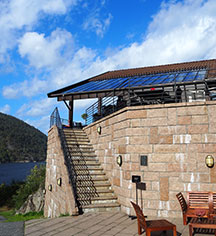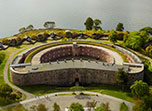Receive for Free - Discover & Explore eNewsletter monthly with advance notice of special offers, packages, and insider savings from 10% - 30% off Best Available Rates at selected hotels.
history
Part of the historic Oscarsborg Fortress, Oscarsborg Castle inhabits a small island located south of the Norwegian capital city. The island itself is specifically situated within a narrow waterway known as the Drøbak Sound (Drøbaksundet), which has been used as a natural defensive point against foreign naval incursions for hundreds of years. While various types of strongholds and citadels have occupied the site intermittently since the 1600s, the first permanent fortress appeared in 1848 following the Napoleonic Wars. Christened the “Oscarsborg Fortress,” it subsequently underwent a series of expansive renovations throughout the remainder of the century. The fort soon possessed a variety of imposing fortifications that included massive armaments made by reputed European manufacturers, as well as a secluded underwater torpedo battery. A ring of neighboring coastal bunkers lined the adjacent shorelines for additional support.
As the war clouds gathered over Europe once more in the late 1930s, the defenses at the Oscarsborg Fortress had become considerably dated. Nevertheless, it performed magnificently at the Battle of Drøbak, when a flotilla of six German warships attempted to attack Oslo at the start of the Norwegian Campaign during the Second World War. As the fleet made its way toward the Oscarsborg Fortress amid the early morning hours of April 9, 1940, the fort’s commanding officer gave the order to launch a surprise bombardment. The main guns barely had time to fire two rounds, but it was enough. Both projectiles slammed into the Blücher—the lead vessel—causing significant structural damage. The final blow occurred when the hidden torpedo battery launched a crippling barrage of missiles that shattered the cruiser’s hull. Fearing the worst, the rest of the fleet withdrew back to the Atlantic. Not only had the Oscarsborg Fortress sunk one of Germany’s most prized ships, it had also bought precious time for the Norwegian Royal Family to evacuate the area. But despite its great success in delaying the invasion, the fort fell to the Axis powers the following day.
After spending the rest of the conflict under German occupation, the Oscarsborg Fortress resumed protecting Oslo from hostile ships once the war had ended. It remained heavily garrisoned throughout the duration of the Cold War, even keeping several of its underwater torpedo bays active during the early 1990s. But in 1993, the fortress began a prolonged period of demobilization that took nearly a decade to complete. The last military facility to operate on the island was the Coastal Artillery Office Training Program, which officially closed down in 2002. Instead of falling into a state of decay, the site quickly emerged as a popular cultural attraction. People from the across the world began flocking to the fortress in great numbers, prompting the conversion of a section of the complex into the current Oscarsborg Hotel & Resort. The Norwegian Directorate of Cultural Heritage even registered the entire location as one of its protected heritage landmarks in 2014. Today, both the Oscarsborg Fortress and Oscarsborg Castle are among Norway’s most fantastic holiday destinations.
Oscarsborg Castle, a member of Historic Hotels Worldwide since 2019, dates back to 1848.



























